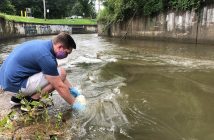A “dysfunctional relationship” between local authorities, poor infrastructure and faecal contamination led to more than 5000 people in Havelock North becoming sick with campylobacter, a government inquiry has found
The outbreak of gastroenteritis in Havelock North in August 2016 saw 5,500 of the town’s 14,000 residents become ill with campylobacteriosis.
Some 45 were subsequently hospitalised, and, the inquiry adds, it is “possible” that the outbreak contributed to three deaths, and an unknown number of residents continue to suffer health complications.
The outbreak was traced to contamination of the drinking water supplied by two bores in Brookvale Road, raising serious questions about the safety and security of New Zealand’s drinking water and leading the government to establish an inquiry into the outbreak in September 2016.
The panel examining the outbreak and its consequences identified several failings by the Hastings District Council, Hawke’s Bay Regional Council and Drinking Water Assessors (DWAs).
Stage one of the two-stage inquiry made several key findings:
- contaminated drinking water was the source of the campylobacter bacterium that caused the gastrointestinal illness campylobacteriosis among Havelock North residents in August 2016, with sheep faeces the likely source of the campylobacter.
- it is highly likely that heavy rain inundated paddocks neighbouring Brookvale Road causing contaminated water to flow into a pond about 90 metres from Brookvale Road bore 1. On 5 and 6 August 2016, water in the pond entered the aquifer and flowed across to Brookvale Road bore 1 where the bore pump drew contaminated water through the bore and into the reticulation system.
- contamination may also have occurred when water from neighbouring paddocks entered roadside drains adjacent to Brookvale Road bores 1 and/or 2 and then entered the bore chambers. If sufficient water had entered the chambers, it could have risen to a level where it overtopped the bore head cable holes and, because the cable seals were loose, travelled down the cables into the water supply. This scenario is regarded as much less likely than travel from the pond to the bore via the aquifer.
- the failings, most notably by the Hawke’s Bay Regional Council and the Hastings District Council, did not directly cause the outbreak, although a different outcome may have occurred in their absence.
- the Regional Council failed to meet its responsibilities, as set out in the Resource Management Act 1991 (“RMA”), to act as guardian of the aquifers under the Heretaunga Plains. Protection of the water source, in this case the aquifer, was the first and a critical step in the multi-barrier approach to ensuring safe drinking water.
- the Regional Council’s knowledge and awareness of aquifer and catchment contamination risks near Brookvale Road fell below required standards. It failed to take specific and effective steps to assess the risks of contamination to the Te Mata aquifer near Brookvale Road and the attendant risks to drinking water-safety. This included through its resource consent processes; its management of the many uncapped or disused bores in the vicinity; its State of the Environment and resource consent monitoring work; and its liaison with the District Council.
- the Regional Council imposed a generic condition on the water take permits it granted to the District Council, related to the safe and serviceable state of the Brookvale Road bores. This condition failed to meet the necessary standard. It then failed adequately to monitor compliance with the conditions of the permits.
- the District Council did not embrace or implement the high standard of care required of a public drinking-water supplier, particularly in light of its experience of a similar outbreak in 1998, and the significant history of transgressions (positive E.coli test results). As a consequence, it made key omissions, including in its assessment of risks to the drinking water supply, and it breached the Drinking-water Standards.
- the District Council’s failings applied especially to its mid-level managers, who delegated tasks but did not adequately supervise or ensure their implementation. This caused unacceptable delays to the preparation of a Water Safety Plan, which was fundamental in addressing the risks of an outbreak of this nature.
- the District Council did not properly manage the maintenance of plant equipment or keep records of that work; and it carried out little or no supervision of necessary follow-up work. Specifically, it was slow to obtain a report on bore head security, a key plank in source water security, and it did not promptly carry out recommended improvements.
- there was a critical lack of collaboration and liaison between the Regional Council and the District Council. The strained nature of this relationship, together with an absence of regular and meaningful cooperation, resulted in a number of missed opportunities that may have prevented the outbreak.
- the DWAs were too hands-off in applying the Drinking-water Standards. They should have been stricter in ensuring the District Council complied with its responsibilities, such as having an Emergency Response Plan and meeting the responsibilities of its Water Safety Plans.
- the DWAs failed to press the District Council sufficiently about the lack of risk assessment, analysis of key aquifer catchment risks, including the link between the Brookvale Road bores and the nearby pond, and a meaningful working relationship between it and the Regional Council. They also failed to require a deeper and more holistic investigation into the unusually high rate of transgressions in the Havelock North and Hastings reticulation systems.
- contingency planning by the District Council was lacking. The District Council had no Contingency Plan (referred to in various contexts also as an Emergency Response Plan), draft boil water notices, or communications plans at the ready.
- consultancy firm MWH New Zealand Ltd (“MWH”), a technical adviser to the District Council, failed competently to assess and report on the security of the bore heads of Brookvale Road bores 1 and 2.
Detailing the findings, panel chair Lyn Stevens QC said the outbreak “shook public confidence” in the fundamental service of providing safe drinking water and raised “serious questions” about the safety and security of New Zealand’s drinking water.
The district and regional councils did not directly cause the outbreak, but their “dysfunctional relationship” and lack of co-operation resulted in a number of missed opportunities that may have prevented it from occurring.
The regional council should also never have launched the prosecution of the district council, which it later withdrew, Stevens said.
The prosecution was “bound to have failed” and the $450,000 the regional council spent on investigating the vase “could have been more wisely spent on investigating the status of the aquifer”.
Stage two of the inquiry will be held later this year to address lessons learned for the future and steps to be implemented to reduce the likelihood of such an outbreak occurring again.




